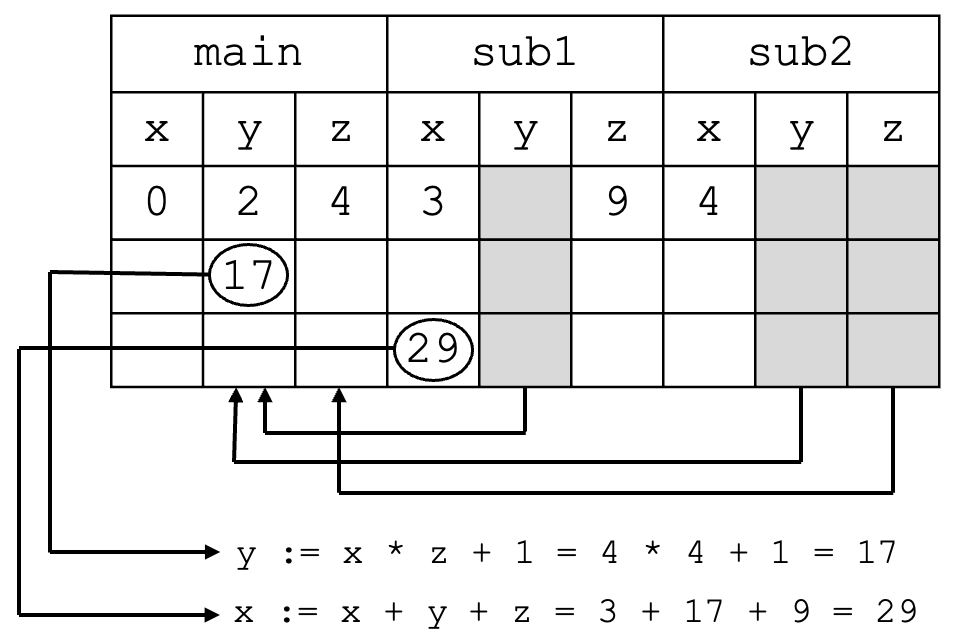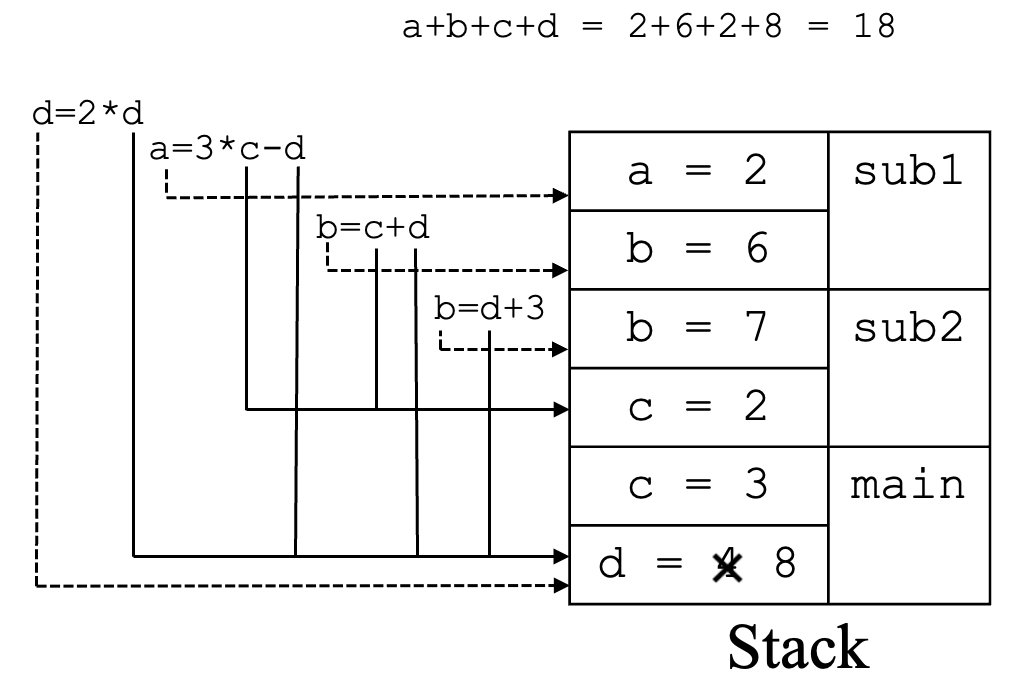Continued from last week
Storage Binding and Lifetime
Static variables
- Bound to memory before program execution starts and remains to be bounded to those cells until program termination
- In Java, it will be allocated if the class is loaded, and will remain until program termination
- Usually for global variables; also for subprograms that are history sensitive
- Efficient because of direct addressing, and no allocation and deallocation during run time is required
- Disadvantages
- Reduces flexibility
- Example: recursive subprograms with only global variables are impossible
- No storage sharing among variables
- Reduces flexibility
Stack-dynamic variables
- Type is statically bound
- Bound to memory cells when the declaration statement is executed
- Supports recursive subprograms
- Run time overhead for allocation and deallocation
Explicit heap-dynamic variables
- Nameless memory cells that are allocated and deallocated by explicit run time instructions
- Can only be referenced through pointer or reference variables
- Example (C++):
int *intnode;
intnode = new int;
// ...
delete intnode;Implicit heap-dynamic variables
- bound to heap storage only when they are assigned values
- Example (JavaScript):
highs = [74, 84, 86, 90, 71];- Highest degree of flexibility by allowing to write highly generic code
- Disadvantages:
- Run time overhead of maintaining all (dynamic) attributes
- Los of error detection at compile time
Scope
Static Scope
- Method o binding names to nonlocal variables introduced in Algol 60
- Can be determined statically (hence the name). i.e., prior to execution
- Permits to determine the type of every variable
- Two types of static stoped languages:
- Those in which subprogram can be nested
- Creates static stope in subprogram
- Ada, JavaScript, Fortran 2003, PHP
- Those in which a subprogram can not be nested
- Any C-based language
- Those in which subprogram can be nested
procedure Big is // Static parent Big
X : Integer; // X is declared
procedure Sub1 is // |
X : Integer. // |
begin. // | Subprogram1, with its own scope
… X …. // | A new `X` is declared
end; // |
procedure Sub2 is. // |
begin. // | Subprogram2, with its own scope
… X … // | No `X` declared, use global X
end; // |
begin // |
… X … // | Which `X` do we use?
end; // | Blocks
Many languages allow new static scopes to be defined ain the midst of executable code via blocks (e.g. for blocks, while blocks, etc.)
void sub() {
int count;
…
while ( …) { // |
int count; // |
… // | While loop is considered a block
count++; // | This code will not run in Java due to
… // | making 2 variables with the same name
} // |
…
}
- Problems:
- Might allow more access to variables and subprograms than necessary
- Program evolution may result in restructuring, thereby destroying the initial structure
Dynamic Scope
- Based in the calling sequence of subprograms
- Can only be determined at run time
- Used in APL, SNOBOL, early LISP
- Perl and COMMON LISP allow variables to be declared to have dynamic scope
procedure Big is
X : Integer; // Global variable
procedure Sub1 is
X : Integer // Local variable
begin
… Sub2 …
end;
procedure Sub2 is
begin
… X … // "Exposing" X variable from Sub1 to Sub2
end;
begin
… Sub1 … Sub2 …. // Sub1 uses local, Sub2 uses global
end;
- Has a profound effect on programming
- Correct attributes of nonlocal variables cannot be determined statically
- References to a name is not always a reference to the same variable
- Local variables can be modified externally
- Programs are difficult to read
- Accessing the variables takes longer
- Reduces the number of parameters in subprograms
- Not widely used
Scope and Lifetime
Sometimes the scope and lifetime of a variable seem to be related.
void myMethod() {
int n;
// ... (no other method called)
}- Scope of
n:- From the declaration to the end of
myMethod(spatial concept)
- From the declaration to the end of
- Lifetime of
n:- Time beginning when the method is entered and ending when execution of the method terminates (temporal concept)
void printHeader() {
// ...
}
void compute() {
int sum;
// ...
printHeader();
// ...
}- Scope of
sum:- From the declaration to the end of
compute
- From the declaration to the end of
- Lifetime of
sum:- Time from when
computeis called, including the time whenprintHeaderis executed, until compute terminates.
- Time from when
Referencing Environment
The referencing environment of a statement is the collection of all variables that are visible in the statement.
The referencing environment heavily depends on the scope of the programming language, i.e., it differs between static and dynamic scope.
Static Scope Example
procedure Example is
A, B : Integer;
procedure Sub1 is
X, Y : Integer;
begin
… // X, Y of Sub1, A,B of Example
end;
procedure Sub2 is
X : Integer;
procedure Sub3 is
X : Integer;
begin
… // X of Sub3, A, B of Example
end; (X of Sub2 is hidden)
begin
… // X of Sub2, A, B of Example
end;
begin
… // A, B of Example
end;
Dynamic Scope Example
void sub1() {
int a, b;
… // a, b of sub1, c of sub2, d of main
} // (c of main and b of sub2 are hidden)
void sub2() {
int b, c;
… // b, c of sub2, d of main
sub1(); // (c of main is hidden)
}
void main() {
int c, d;
… // c, d of main
sub2();
}
Static Scope Example 2
procedure main is
x,y,z : Integer;
procedure sub1 is
x,z : Integer;
begin
x := 3;
z := 9;
sub2();
x := x + y + z;
print(x)
end
procedure sub2 is
x : Integer;
begin
x := 4;
y := x * z + 1
end
begin
x := 0;
y := 2;
z := 4;
sub1()
end

End of lecture 1
You do not need to draw out the whole table, but it it good as you can get most marks from showing your work vs just writing an answer.
Dynamic Scope Example 2
procedure main is
x,y,z : Integer;
procedure sub1 is
x,z : Integer;
begin
x := 3;
z := 9;
sub2();
x := x + y + z;
print(x)
end
procedure sub2 is
x : Integer;
begin
x := 4;
y := x * z + 1
end
begin
x := 0;
y := 2;
z := 4;
sub1()
end

Named Constants
A named constant is a variable that is bound to a value only once.
- Useful aid to improve readability and reliability
- Can be used to parametrize programs (modifications only in one spot)
- Static binding of issue
- Only previously named constant, constant values, and operators are allowed in assigning a value to the named constant (FORTRAN)
- Dynamic binding of value
- C++ allows static binding (
const) or dynamic binding (readonly)
Data Types
A data type defines a collection of data values and a set of predefined operations on those values
- Early languages (pre Fortran 90) had only a few data structures. More complex data had to be implemented
- COBOL was the first language that allowed more data types to be defined by the user
- e.g. arbitrary decimal data types, records
- ALGOL 68 introduced a new approach by providing a few basic types and flexible structure-defining operators that allow the programmer to design a data structure for their need
- Later, that idea lead to abstract data types, interfaces, and object-orientation
Numeric Data Types
Most early programming languages had only numeric data types.
Integer
- Most common primitive numeric data type
- Languages often support different sizes
- e.g. in Java, we have
byte,short,int, andlong
- e.g. in Java, we have
- Some languages have unlimited integers
- e.g. in Haskell, type
Integer
- e.g. in Haskell, type
- Some languages have unsigned integer types
- Most integer types are directly supported by the hardware
- Bitwise operations
- Twos complement representation
Floating-point
- Model real numbers
- Approximation, not precise value
- Loss of accuracy through arithmetic operation
- Represented by fraction and exponent
- IEEE Floating-Point Standard 754
- 1 sign bit, 8 exponent bits, 23 fraction/mantissa bits
- 1 sign bit, 11 exponent bits, 52 fraction/mantissa bits
- IEEE Floating-Point Standard 754
- Often two data types
floatanddouble
- Precision and range
- Precision is the accuracy of the fraction part
- Range of fraction
- Range of exponent
Decimal
- Fixed number of decimal digits
- Primary data types for business data processing
- Usually stored by using binary codes for decimal digits
- Binary Coded Decimal (BCD)
- Precise representation
- Wasteful representation
- 1 or 2 digits per byte
Boolean Types
Boolean types are the simplest of all types.
- Two values:
trueorfalse - Introduced in ALGOL 60
- Previously used a system like:
if x > 5 GOTO place
- Previously used a system like:
- Some languages use/allow numeric expressions as conditionals
- Could be represented by a single bit but use typically a byte
- 8 booleans could fit in a byte
- Typically use a full byte because it is easier to get a byte than a single bit
Character Types
Character data are stored as numeric codings
ASCII
American Standard Code for Information Interchange
- 7-bit encoding allowing an additional bit for parity
ISO 8859-1
- 8-bit encoding
Unicode
- 4 byte character codes UCS- or UTF-32
Strings
A string is a sequence of characters.
Design issues:
- Should strings simply be a special kind of character array or a primitive type?
- Should strings have static or dynamic length?
Operations on strings:
- Assignment
- Catenation
- Substring reference
- Comparison
- Pattern matching
Strings (C++)
chararray- String is terminated by character 0
- Operations through standard libraries
- Inherently Unsafe (e.g.
strcpy)
- Inherently Unsafe (e.g.
Strings (Fortran 95 and Python)
- Strings are a primitive type
- Relational operators, assignment, catenation, substring reference built in
- Python adds indexing, searching and replacing
Strings (Java)
Stringclass- Constant strings
StringBufferorStringBuilderclasses- Changeable strings
Strings (Perl, JavaScript, Ruby, PHP)
- include built-in pattern matching operations (regex)